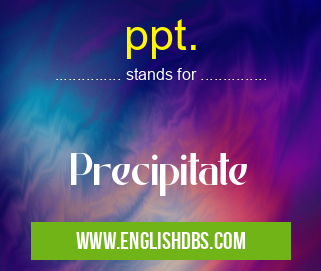What does PPT. mean in CHEMISTRY
Ppt. is an abbreviation for precipitate, which in science refers to a solid substance that forms as a result of two solutions being mixed together. A precipitate is usually insoluble in water and will often appear as a white or colored solid when added to another solution. It can also refer to the process of allowing the two solutions to mix and then allowing the precipitate that forms to settle out of the solution. Precipitation can occur in either chemical reactions or physical processes.

ppt. meaning in Chemistry in Academic & Science
ppt. mostly used in an acronym Chemistry in Category Academic & Science that means Precipitate
Shorthand: ppt.,
Full Form: Precipitate
For more information of "Precipitate", see the section below.
Uses Of Ppt.
Ppt., or precipitate, has many uses in science laboratories across different fields such as chemistry, biology, medicine, environmental science and engineering. For example, scientists use precipitation techniques for chemical synthesis, purification of proteins and peptides, chromatography experiments (e.g., thin layer chromatography), determination of ionic concentrations in samples, analysis of metal ions in solution and determination of elemental composition by X-ray diffraction patterns.
Essential Questions and Answers on Precipitate in "SCIENCE»CHEMISTRY"
What is precipitate?
Precipitate is the formation of solid particles from a solution or suspension. It occurs when two or more substances react together and form an insoluble compound. This reaction may be caused by a chemical change, physical change, or a combination of the two. This process is often referred to as precipitation.
What factors can affect precipitation?
Factors that can affect precipitation include temperature, humidity, air pressure, cloud cover, and wind speed. These influences can create different levels of moisture in the atmosphere which drives the rate of precipitation.
How does temperature affect precipitate?
The rate of precipitation is affected by temperature in several ways. Warmer temperatures decrease the density of air molecules and cause them to rise higher into the atmosphere, resulting in less rainfall near ground level. On the other hand, colder temperatures tend to increase the density of air molecules and cause them to stay closer to ground level, resulting in higher rates of rainfall near areas on earth with lower temperature gradients such as mountainous regions.
How does humidity affect precipitate?
Relative humidity has an effect on precipitation because it influences how much water vapor is present in the atmosphere at any given time. High relative humidity promotes condensation of atmospheric water vapor which leads to cloud growth and ultimately rain or snowfall. Low relative humidity on the other hand tends to inhibit this process by decreasing evaporation and thus decreasing potential cloud formation.
How does air pressure affect precipitate?
Atmospheric pressure plays an important role in determining where large scale weather systems move and how they interact with each other across long distances; this inevitably affects local weather such as patterns in precipitation over time. Generally speaking, low-pressure systems result in greater amounts of rainfall while high-pressure systems inhibit rain due to their suppressing effects on cloud formation processes.
How does wind speed affect precipitate?
Wind speed also factors into the equation; if winds are strong enough they might disrupt clouds before they have had a chance for condensation - thereby reducing potential for precipitation - or they might be strong enough prevent surrounding clouds from dissipating until after they have already released significant amounts (or all) their rain or snow content onto an area downwind from them - leading to sudden intense showers instead your typical steady drops over time associated with gentle winds instead.
What forms can precipitates take?
Precipitates may manifest themselves as dust particles, mist droplets, fog droplets, hail stones, snow flakes etc., depending upon their composition and existing environmental conditions such as temperature ranges and wind speeds at given moments.
Final Words:
In conclusion, ppt., short for precipitate is an important scientific term which refers to a solid material that arises from the combination of two liquids due to either physical processes or chemical reactions taking place between them resulting in an insoluble material settling out of solution as a white or colored solid. With its various uses throughout different scientific fields this term has become commonplace among scientists all over the world making it a key part of any laboratory setting.
